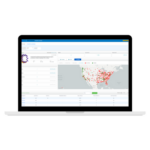How Grocery Retail Can Confront Inflation
Inflation has officially hit our wallets and almost all shoppers—90%—have noticed. Consumers report substantial price hikes specifically for gasoline and groceries.
That’s right. Food prices have soared by 14.3% year-over-year. Everything from beans to peanut butter have higher price tags. The cost of eggs has jumped 38%. Ground, roasted coffee prices increased more than 28%. In the grocery sector, the online channel (+21.5%) and dollar channel (+19.2%) have the highest year-over-year inflation rates.
Much of the year-over-year growth in grocery spending is due to inflation, not consumption. When it comes to gasoline, travel, and restaurants, consumers are paying more but consuming less.
In an effort to spend less money, Americans are adjusting how they shop and what they buy.
It may surprise you that convenience is no longer king. Most people now prefer to pay less versus receive an order as fast as possible. As a matter of fact, the latest data shows that people opt for pickup over delivery because they don’t want to wait at home for their orders to arrive. In the past year, 60% of US households have used pickup. One reason shoppers shy away from grocery delivery services is to avoid paying more than necessary. “It’s understandable that you may want to find ways to pay less given inflation’s impact on purchasing power,” Mark Fairhurst, vice president of marketing at Mercatus says.
79% of US shoppers say they look for discounts to save money. 60% of consumers choose less-expensive alternatives to their favorite brands. Consumers respond to higher prices “by shopping promotions, prioritizing value options, and trading down to avoid going without,” notes Krishnakumar Davey, president of thought leadership for CPG and retail at consumer goods market researcher IRI.
Remember how during the pandemic shoppers bought whatever items were available? Now, it’s all about cost. Alan Mile, CEO of NCSolutions explains that “value is the centerpiece more often than availability” and that “consumers are selecting brands and products to stretch their budgets as far as possible.”
Consumers aren’t the only ones noticing extreme prices. Inflation impacts grocery retailers and consumer goods brands too! Costs are higher for fuel, materials, and labor — companies must balance price and profit.
Price Increases for Retailers
Prices are rising across channels. And for retail, that means possible cash flow disruptions, excess supply, reduced revenues, and lessened margins.
Grocery Dive reports that people think that the inflation they see when buying food at the supermarket is even higher than statistics indicate. A group of consumers that were polled in July 2022 said they thought food-at-home prices were rising at an annual rate of almost 23%… that’s about 10 percentage points higher than the actual figure.
And, a PYMNTS study learned that 69% of consumers found product price increases for groceries to be very or extremely considerable.
Experts expect inflation to continue, so many large retailers have adjusted their revenue estimates for 2023. Walmart and Target have already cut their profit outlooks for the year.
Let’s look at how inflation impacts our world…
Online: Amazon Prime Day Example
Amazon hosted its second Prime sale of the year in October 2022 and the reaction reveals how inflation-wary consumers are shopping.
In the sale’s first 30 hours, 24% of buyers purchased toys or video games (up from 15% during July’s Prime Day). But when it comes to grocery items, there was about a 23% drop in sales.
Nearly one-third (31%) of Prime Easily Access shoppers purchased holiday gifts during the sale and 43% of Prime’s shoppers also shopped at other early holiday sales events (like Target Deals days and Walmart Deals for Days).
80% of Prime Early Access shoppers say inflation impacted their shopping behaviors, compared to 84% who said the same during July’s Prime Day.
In-Store: Giant Eagle Example
Sure, suppliers ask for a modest price increase every so often… but in these inflationary times, more CPGs are requesting considerable price increases.
Don Clark, chief merchandising officer for the Pittsburgh-based grocery store Giant Eagle says they have to entertain these price increases because the supplier could threaten to not ship product. He says, “We have conversations with suppliers to help them understand that we can’t absorb all of it either.”
Clark adds that Giant Eagle uses a carrot-and-stick approach — for suppliers willing to minimize price hikes, the grocer responds with a promotion or store display.
Suppliers that insist on price increases, might see Giant Eagle step up the promotion of its lower-price private label products and give those items better shelf space. In some cases, the retailer might drop a product altogether.
Before Giant Eagle agrees to any increase, Giant Eagle asks the manufacturer to show proof of the higher costs, such as commodity or labor reports, labor, or transportation.
Brand Earnings: PepsiCo Example
In October 2022, PepsiCo beat profit estimates for the third quarter and raised its forecast for the year. The company’s price hikes fueled double-digit gains in sales despite lower volumes of snack purchases. Globally, snack volumes fell 1.5% but the beverage category grew 3%.
While PepsiCo acknowledges that consumers are cautious with their spending, they also claim that “when times are bad, we’re the little treat that they [re: consumers] have.”
Benefits to an Omnichannel Strategy
Adobe Analytics predicts consumers will spend $209.7 billion online between November 1 and December 31 – a 2.5% increase year-over-year from the $204.5 billion spent online in 2021. “Even though we expect to see single-digit growth online this season, it is notable that consumers have already spent over $590 billion online this year at 8.9% growth, highlighting the resiliency of e-commerce demand,” says Patrick Brown, vice president of growth marketing and insights at Adobe.
Driven by the pandemic, today’s consumer is extremely comfortable shopping online. Retailers noticed the new habit and built out e-commerce experiences and started in-store or curbside pickup options. Since omnichannel is here to stay, we recommend that grocery retailers who operate their e-com and brick-and-mortar operations separately unify the strategy!
For Albertsons, omnichannel grocery shopping includes multiple digital tools (from curated shopping lists to telemedicine) that build synergy between the online and offline experience.
And during this year’s Groceryshop, Instacart CEO Fidji Simo told attendees the company’s new suite of tools grew out of conversations with grocers who said consumers who shop both online and offline are “way more valuable than an online-only consumer or an in-store only customer.”
As consumers focus more on price than convenience, omnichannel strategies should focus on consistency. Think of the whole picture… important elements like assortment and availability are incredibly important. Putting price first shouldn’t sacrifice your selection and speed.
Competitive Intelligence to the Rescue
Rising prices makes for strong competition. To better understand your direction and other grocery retailers’ efforts, competitive intelligence solutions are a key differentiator.
With competitive intelligence, grocery retailers…
- Resolve inaccurate competitive catalog matching
- Identify gaps in promotions and ensure visibility of active promotions
- Automate data mapping and cleansing
- Increase market share
According to McKinsey, US consumers have switched brands and retailers more this year than at any time since the pandemic began. And guess what? Pricing is the biggest motivation.
Are you closely monitoring your competitors pricing and promotional strategies? Did you know that you can? Are you reviewing availability issues? How are inflation-impacted categories performing? At Bungee Tech, we give you accurate data in a digestible format. Take competitive intelligence and make smart decisions to improve your profitability.
If you’re interested in getting high-quality data to better recognize market penetration, opportunity gaps, and understand how your pricing strategy compares to others, let us know.
Create Valuable Opportunities
Of course, you can’t control inflation, but you can take a closer look at where to improve your strategy.
Retailers have taken note of consumer behavior changes like growing interest in private labels, and fewer grocery trips. But not every retailer has looked closely at data trends. Put your competitive intelligence to the test!
Here are a few areas to target:
Category Strategy: Reconsider your category strategies. Know what category sales contribute to the most shopping baskets. Put a number to the price gap between your private label brand and national brands. Understand your market share vs. your key competitors.
Winning grocery store understand how changing consumer preferences redefine some categories. Let’s take household cleaning, a category that changed dramatically during COVID. Think about the candy category and its seasonality.
Pricing & Promotion Approach: Distinguish your price and promotion strategies. Know your consumer sentiment – will price increases cause shoppers to switch stores? How can you provide customers more value? Where does your competition have an edge?

As McKinsey notes, the future will belong to those willing to reshape their capabilities and grow resilience.
Want to learn more about competitive intelligence? Give us a shout – we’d love to connect!





